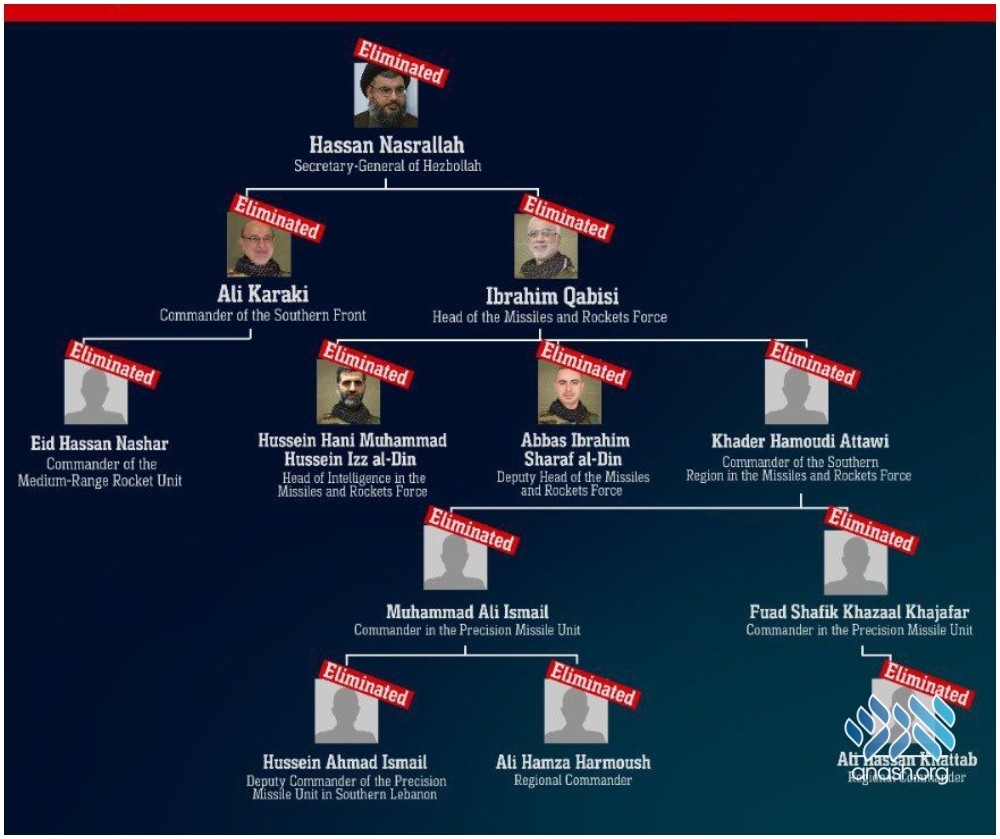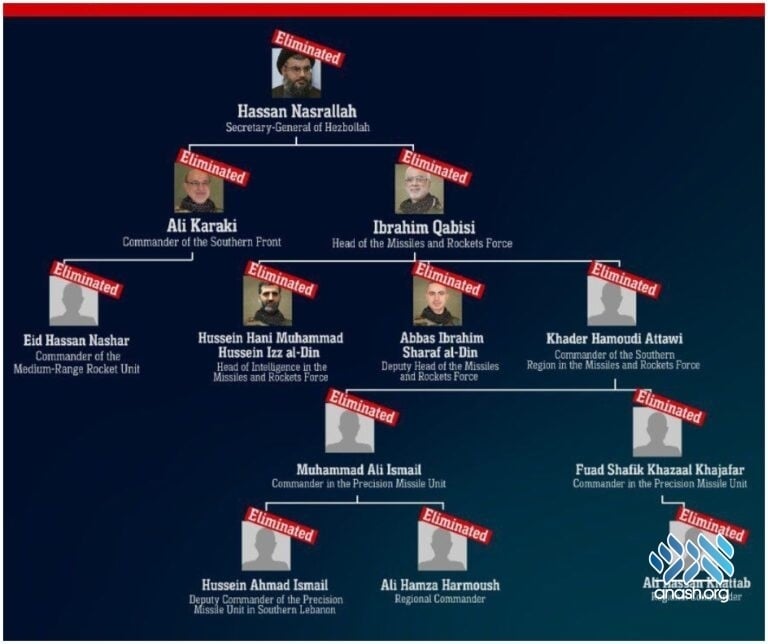כ״ח אלול ה׳תשפ״ד | September 30, 2024
War Day 360: Hamas Militia Defeated, Lebanon Ground Entry Began
War Summary, Day 360: Hamas’s military in Gaza has been defeated and all that’s left of it is a guerrilla terror group which will take time to dismantle completely, rround 2:00 AM on Tuesday morning, the IDF confirmed that a limited incursion has begun in several border area villages in Southern Lebanon, and Israel has wiped out the top echelons of Hezbollah and most of the middle as well.

War Summary, Day 360: Hamas’s military in Gaza has been defeated and all that’s left of it is a guerrilla terror group which will take time to dismantle completely, rround 2:00 AM on Tuesday morning, the IDF confirmed that a limited incursion has begun in several border area villages in Southern Lebanon, and Israel has wiped out the top echelons of Hezbollah and most of the middle as well.
By Mrs. Bruria Efune
War Summary, Day 360:
101 held captive in Gaza.
35 hostages confirmed murdered held in Gaza.
117 living hostages rescued.
37 hostage bodies rescued.
1,652 Israelis killed.
350 fallen soldiers and police in the battle in Gaza.
25 fallen soldiers in Northern Israel.
14 fallen soldiers and police in Judea & Samaria.
25,000 estimated projectiles fired at Israel.
88,000 Israelis displaced from their homes.
1 Jewish nation united in prayer, charity, and good deeds.
Top Headlines:
- Hamas’s military declared largely defeated
- IDF ground entry into Lebanon has begun
- Nasrallah and 15 other top terrorists eliminated within days
- Israel refusing all ceasefire proposals, may work to completely dismantle Hezbollah
- IDF controls Lebanon’s ground, air, and sea borders.
- Hezbollah fires towards Jerusalem
- IDF no longer working to avoid war with Iran
- Houthis fire towards Tel Aviv
- Heavy airstrikes in Yemen
Hostage Updates:
While negotiations have fallen through, the IDF is working towards an alternative plan to bring the hostages home.
Gaza Front Updates:
According to the IDF’s assessment, Hamas’s military in Gaza has been defeated, and all that’s left of it is a guerrilla terror group, which will take time to completely dismantle—according to some estimates, at least one year. While small Hamas groups still manage to put up little attacks on troops in Gaza, they are barely able to launch rockets at Israel anymore, thank G-d.
The IDF says that dismantling the remains of Hamas is the most important goal of the war in the south, but returning the hostages home is the most urgent, as the hostages don’t have much time left.
Three divisions of IDF troops are currently operating in Gaza: the 252nd Division along the Netzarim Corridor, and pinpoint operations in Central Gaza and Gaza City; the 162nd Division in Rafah and along the Philadelphi Corridor; and the Gaza Division in the buffer zone.
The IDF is continuing with pinpoint operations and targeted airstrikes, to remove Hamas infrastructure and terrorists. Between 15-40 terrorists were eliminated per day over the last week.
Amongst eliminated terrorists last week, were several who participated in the October 7th massacre, including:
- Suleiman Abu Lafi, who was involved in smuggling arms into Gaza and directing attacks in Judea & Samaria.
- Abdullah Abu Lafi, a member of the Palestinian Islamic Jihad.
- A Nukhba Force commander who invaded Israel during the massacre on October 7.
Hamas continues to build their command rooms in school buildings which are being used as shelters. The IDF uses cautious precision strikes when hitting the site, in order to minimize harm to civilians. Over the past four days, the IDF struck one in Beit Lahiya, and one in Jabaliya, both in Northern Gaza.
Troops on ground recently located a kilometer-long tunnel in Central Gaza, which was built under a civilian neighborhood. The tunnel, which was destroyed last week, contained several rooms, equipment, and weapons.
Northern Front Updates:
Hezbollah’s attacks on Israel in recent days has been significantly less than expected, with between 100-150 rockets, missiles, and drones launched per day. Most are launched at border communities, then at Kiryat Shemona and Tzfat. Further launches reach the Nazareth area, and occasionally Haifa. A few missiles reached as far as the Shomron area, near Jerusalem. Almost all projectiles aimed at populated areas have been successfully intercepted, with a small number of hits, including one in Tzfat. Casualties have been remarkably lower than expected, thank G-d, with just a few light to moderate injuries.
Larger missiles trigger sirens in a wider area, due to the expanded range in case of an aerial interception. One single missile headed towards Ma’ale Adumim, near Jerusalem, triggered sirens in a large area. The missile landed in an empty area, causing a fire and some power outages in nearby villages.
In a surprising turn of events, Home Front Command eased restrictions in parts of the Haifa area, allowing schools to resume where bomb shelters are accessible, and allowing indoor gatherings of up to 300 people.
Over the last 10 days, the IDF took out almost the entirety of Hezbollah’s top leadership, and much of the middle leadership, and destroyed or disabled most of its missile capabilities. Israel now controls all of Lebanon’s borders and airspace. However, Hezbollah is not defeated, and if given time undisturbed, still has the ability to regroup with its militia of 20,000+ terrorists. Israel has the choice between a) taking the momentum and entirely destroying Hezbollah, or, b) accepting ceasefire proposals under which Lebanon will enforce UN Resolution 1171, and take responsibility for keeping Hezbollah behind the Litany River. The second choice still fills the goal of the war “to allow the residents of the north to return home safely,” but not with long-term results.
It appears that Israel has chosen the first option, as IDF Chief of Staff Lt. Gen. Herzi Halevi said, “We are determined to continue to destroy the Hezbollah terror group. We are determined to continue fighting.”
The Israeli government’s choosing to eliminate Hezbollah Secretary General, Hassan Nasrallah, came with a deliberate choice to steer the war from the cautious and limited route, to the possibility of completely destroying Hezbollah.
Nasrallah’s bunker was under a complex of six apartment buildings, in Dahiyeh, an urban suburb of Beirut. The IDF hit it with around 80 tons of bombs, dropped by multiple military jets in the form of dozens of munitions, one after the other. He was killed along with several high-ranking Hezbollah officials.
After eliminating Nasrallah, the IDF called on residents of Dahiyeh to evacuate, as even more bombings continued to hit Hezbollah’s most important assets, where no one expected the IDF to target, marking the dramatic escalation.
Amongst the most senior Hezbollah terrorists eliminated since Wednesday, are:
- Mohammed Srur, commander of Hezbollah’s aerial forces, Wednesday night, in Beirut.
- Ibrahim Qubaisi, commander of Hezbollah’s rocket and missile division, (along with Abbas Sharafeddine, Qubaisi’s deputy, and Hussein Ezzeddine, a senior commander in the division) in Beirut, on Thursday.
- Muhammed Ismail, commander of Hezbollah’s rocket and missile unit in southern Lebanon, recently.
- Ali Karaki, the commander of Hezbollah’s Southern Front, with Nasrallah on Friday, in Beirut.
- Ibrahim Hussein Jazini, head of Nasrallah’s personal security unit, and one of his closest confidents, with Nasrallah on Friday, in Beirut.
- Samir Tawfik Diab, an advisor to Nasrallah, and one of his closest confidents, with Nasrallah on Friday, in Beirut.
- Abd al-Amir Muhammad Siblini, responsible for Hezbollah’s force build-up, with Nasrallah on Friday, in Beirut.
- Ali Nawaf Ayoub, responsible for Hezbollah’s firepower, with Nasrallah on Friday, in Beirut.
- Eid Hassan Nashar, commander of Hezbollah’s medium-range rockets unit, on Shabbat, in Beirut.
- Hassan Khalil Yassin, commander of a unit in Hezbollah’s intelligence division, on Shabbat, in Dahiyehm near Beirut
- Nabil Qaouk, the deputy head of Hezbollah’s executive council, on Shabbat, in Beirut.
In addition, several non-Hezbollah terrorist leaders were eliminated, including:
- Ahmed Muhammad Fahd, head of a Hamas network in southern Syria, Friday night, in Syria.
- Abbas Nilforoushan, deputy commander of Iran’s IRGC Quds Force, with Nasrallah on Friday, in Beirut.
- Fateh Sherif, head of Hamas branch in Lebanon, and UNRWA Lebanon school principal, Sunday night, Southern Lebanon.
- Nidal Abd al-Aal, commander of the Popular Front for the Liberation of Palestine (PFLP) in Lebanon, was involved in planning and advancing terror attacks in Judea & Samaria, Sunday night, in Beirut.
The IAF dropped an astonishing 3,500 munitions on Hezbollah sites last week.
In destroying Hezbollah’s top firing capabilities: On Friday, night, before bringing the Israeli Navy closer to Beirut, the IDF destroyed six warehouses of anti-ship missiles in Beirut. On Monday, the IDF destroyed a cache of surface-to-air missiles, which Hezbollah stored right near Beirut’s international airport, threatening both military and passenger planes. The IDF also destroyed many caches of medium and long-range missiles.
The IDF also imposed a full military blockade on Lebanon, to prevent weapons from being smuggled in from Iran—through sea, air, or land. On Shabbat, the IDF took control of the Beirut airport’s control tower radio, and warned that any Iranian plane would be targeted. The airport controllers were later seen refusing landing to a few Iranian planes. On land, the IDF has been relentlessly targeting smuggling routes between Syria and Lebanon.
On Monday, the political security cabinet officially approved the next phase of the operation in Lebanon, which is a ground operation. American officials had already leaked that Israel promised a limited ground operation. (The Israeli government and security officials are growing tired of systematic leaks from American officials, and have been keeping some information from them lately, including the plans to eliminate Nasrallah. The word “limited” might not be entirely accurate.)
The goal of the ground maneuver will be to remove Hezbollah’s presence from Southern Lebanon. Southern Lebanon is a mountainous area, full of brushes and forests, where it is easy to hide. The Litany River market the border for Lebanon’s lowlands, from where it’s harder for Hezbollah to fire at Israel, or to hide. Hezbollah has a lot of infrastructure in Southern Lebanon which is difficult to destroy from above—particularly tunnels which are inside of mountains. There are also too many places for terrorists to hide from the Air Force, and they will need to be pushed out by ground forces.
In recent months, IDF special forces have already been operating on small missions in Lebanon, to prepare for a ground maneuver, and have even operated inside tunnels. This information was largely censored until now (though equipment donated by readers has been used in some of these operations).
In recent days, Northern Command chief Maj. Gen. Ori Gordin met with the commanders of the 98th, 36th and 91st divisions, to approve plans. These will likely be the first divisions to enter Lebanon.
On Monday evening, the IDF imposed a closed military zone in the Metula, Misgav Am and Kfar Giladi area.
The Lebanese Army and UNIFIL forces were seen retreating several kilometers back from the border area.
Around 2:00 AM, between Monday and Tuesday, the IDF confirmed that a limited incursion has begun in several border area villages in Southern Lebanon. Ground Forces are being supported by the Air Force and artillery fire.
Judea and Samaria Updates:
The IDF has called up three reserve battalions for activities in the Central Command, which is largely responsible for the Judea and Samaria areas. The IDF says that the reservists will be deployed for operational missions and bolstering defenses.
Houthi & Iraqi War Front Updates:
On Shabbat the Houthis in Yemen fired a surface-to-surface ballistic missile towards Tel Aviv. It was shot down by the Arrow long-range missile defense system just outside of Israel’s borders. Sirens sounded across Central Israel, due to the wide range of falling shrapnel from the interception. This follows another Houthi ballistic missile interception on Wednesday, the third this month.
On Sunday, the IAF struck back, with dozens of aircraft, including fighter jets, refuelers, and spy planes, attacking Houthi sites in Yemen, around 1,800 kilometers from Israel. The strikes targeted Houthi terror sites at the Hodeidah and the nearby Ras Isa port in western Yemen, including power plants and a port, which are used to import oil (for launching missiles) and Iranian weapons.
The Iran-backed Islamic Resistance in Iraq has also been busy attacking Israel. On Sunday, the IDF intercepted a drone attack before it entered Israel’s territory outside Eilat, and again on Monday.
Iran & Proxies Attack Updates:
Cleared for publication on Monday evening: A day before eliminating Nasrallah, the Israeli political war cabinet approved a subtle but significant change in the objectives of the war. Instead of “avoid a broad war that involves Iran,” the objective is now “minimize a multi-front war.” The shift from “avoid” to “minimize,” and the dropping of specifying Iran, has significant implications.
After Nasrallah’s elimination, the Iranian regime declared 5 days of mourning, and promised revenge “when the time is right.”
Prime Minister Netanyahu released a video on Monday, in which he directly addresses the people of Lebanon, and not the regime rulers. He speaks of what the historically rich country could be without the corrupt terror-sponsoring regime, and subtly comments, “when Iran is finally free—and that moment will come a lot sooner than people think—…“ A majority of the people in Iran have long been protesting the cruel regime, and hoping for its ending.
Hezbollah has always been one of Iran’s biggest deterrents to stop Israel from attacking Iran, and particularly their nuclear plants. With the threat of Hezbollah fire significantly diminished, Iran now feels exposed. The regime already moved their leader, Ayatollah Khameini, to a secure place.
(The “secure place” might be just as secure as Nasrallah was. Today, in an interview with CNN in Turkey, former Iranian President Ahmadinejad related that several years ago Iran established a special unit to combat Mossad activities inside Iran. But in the ultimate irony, the head of the special unit turned out to be a Mossad agent, as did 20 of the unit’s top agents. The counter-Mossad Mossad group stole nuclear documents, assassinated Iranian nuclear scientists, and then fled to Israel before being discovered.)
While Iran hasn’t carried out any direct attacks yet, the Shin Bet warned that Iran has been increasingly trying to carry out a high-profile assassination in Israel. The regime has been attempting to recruit Israelis, by offering large sums of money, and starting with offers for small tasks, such as spraying graffiti or leaving objects in specific places. Israelis are asked to remain alert to offers, especially if the pay is disproportionate to the given task.
The airstrikes that eliminated Nasrallah
Rocket lands in Tzfat



Thank you for this clear update.
May Eretz Yisroel experience a miraculous and quick Victory!
Where can I donate toward the soldiers?